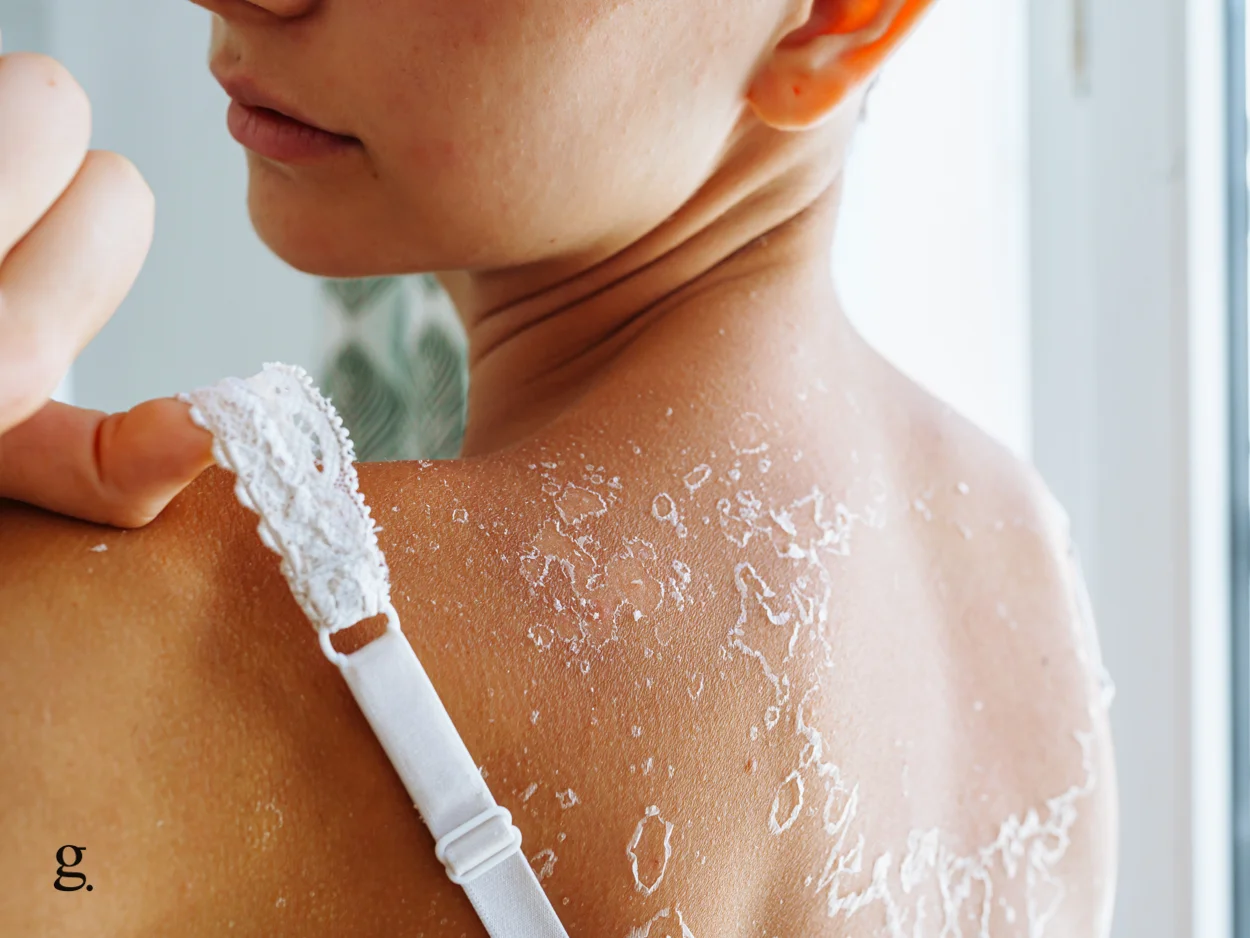Summertime is the perfect opportunity to enjoy the outdoors and soak up some vitamin D, but it’s important to remember to protect your skin from the sun’s harmful rays.
If you don’t, you may end up with a nasty sunburn, and annoying peeling skin once it starts to heal.
While the best way is to just let it peel and allow your body to do its thing, if you absolutely must remove the peeling, there are a few things you can do to help get rid of it quicker.
1. The gentle chemical exfoliation method
The gentle chemical exfoliation method is an excellent choice for removing peeling skin from sunburn without causing further irritation. This approach relies on mild, skin-friendly acids that work to dissolve the dead skin cells gently, allowing for a smoother and more even complexion.
- Choose the right product: Look for a gentle chemical exfoliant with ingredients like alpha hydroxy acids (AHAs) or beta hydroxy acids (BHAs), such as glycolic acid, lactic acid, or salicylic acid. Make sure to opt for a product with a low concentration of these acids (ideally around 0.5-1.5%), as higher concentrations can be too harsh on sunburned skin.
- Apply the exfoliant: Follow the instructions on your chosen product, and apply a thin layer to the affected area. Make sure to avoid any open cuts or abrasions, as the acids can cause stinging and further irritation.
- Leave on for the appropriate time: Most chemical exfoliants need to be left on the skin for a specific period, typically ranging from 5 to 20 minutes. Always follow the recommended time on the product’s label and never leave it on longer than instructed.
- Rinse off thoroughly: After the appropriate time has passed, rinse off the exfoliant with lukewarm water. Make sure to remove all traces of the product to avoid any potential irritation.
Remember, it’s essential to be patient and gentle with your skin during this process. While chemical exfoliation can help remove peeling skin, overdoing it can lead to more harm than good. Listen to your skin and discontinue use if you experience increased sensitivity or irritation.
A note from the editor: absolutely do not consider using a peel product (i.e. a chemical exfoliant with concentrations 5% or higher) on your peeling sunburn, as this could seriously irritate or even cause damage to your skin. These types of products are way too potent to be put on damaged skin.
2. The scrub method
The scrub method can be an effective way to remove peeling skin from sunburn, but it’s essential to approach this technique with caution. Physical exfoliation can sometimes be too abrasive for sunburned skin, so it’s crucial to use a gentle scrub and a light touch.
- Select a gentle scrub: Look for a scrub with fine, smooth particles like jojoba beads or finely ground oatmeal. Avoid scrubs with large, rough particles like walnut shells, as they can further irritate and damage the skin.
- Apply the scrub: Scoop a small amount of the scrub onto your fingertips and gently massage it onto the peeling skin using light, circular motions. Be extra gentle, and avoid applying pressure, as this can cause more harm to your already sensitive skin.
- Keep it brief: Limit your scrubbing session to no more than 30 seconds to a minute, as over-exfoliating can worsen the situation and lead to further irritation.
- Rinse off the scrub: Use lukewarm water to thoroughly rinse away the scrub from your skin, ensuring all particles are removed.
When using the scrub method, it’s crucial to pay attention to your skin’s response. If you notice any increased redness, stinging, or irritation, stop the scrubbing immediately and opt for a more gentle approach, like the chemical exfoliation method mentioned earlier.
3. The Brush Method
The brush method involves using a soft-bristled brush to gently slough away peeling skin from sunburn. This technique can be effective when done correctly, but it’s important to be extremely gentle to avoid causing additional irritation or damage to the skin.
- Choose a soft-bristled brush: Opt for a brush specifically designed for facial or sensitive skin. It should have very soft bristles that won’t scratch or irritate the skin.
- Cleanse your skin: Gently cleanse the affected area with a mild, fragrance-free cleanser to remove any dirt and oil. Pat your skin dry with a soft towel without rubbing or tugging.
- Wet the brush: Dampen the brush with lukewarm water to soften the bristles further and make them more gentle on your skin.
- Gently brush the skin: With a light touch, use the damp brush to sweep over the peeling skin in gentle, upward strokes. Be cautious not to press too hard or move too quickly, as this could cause irritation.
- Keep it short: Limit your brushing session to no more than 1-2 minutes, as overdoing it can lead to further damage and irritation.
- Rinse your skin: After brushing, rinse your skin with lukewarm water to remove any loosened skin flakes.
- Moisturize: Finish by applying a generous amount of a fragrance-free, hydrating moisturizer to help soothe and heal the skin.
It’s important to remember that the brush method should only be used with extreme care, as sunburned skin is very delicate and prone to damage. If you notice any increased redness, discomfort, or irritation while brushing, stop immediately.
The Best Types of Skincare Brushes To Use
When choosing a skincare brush for sunburned skin, it’s essential to look for options that are designed for gentle exfoliation and sensitive skin. Some of the best types of skincare brushes to use include:
Facial cleansing brushes
These brushes often have ultra-soft bristles and are specifically designed for use on delicate facial skin. Look for a brush labeled as suitable for sensitive skin.
Baby brushes
Baby brushes are designed to be gentle on an infant’s delicate scalp, making them a good option for sunburned skin. These brushes usually have very soft, fine bristles that won’t cause irritation.
Silicone brushes
Silicone brushes have smooth, flexible bristles that can provide gentle exfoliation without causing damage to sensitive skin. Opt for a brush with a fine, soft texture for the best results.
4. The moisturizer method
This method involves completely saturating the area of peeling sunburn with a heavy-weight moisturizing lotion (like an after-sun cream).
Thoroughly work the lotion into all the loose, peeling skin, and allow a couple of minutes for it to sink into the dead skin properly, then place the palm of your hand on the area, and in a firm, circular motion with a decent amount of pressure, gradually start rubbing away.
You should see the peeling skin start to come away from the new skin beneath – continue until all the peeling skin that’s going come off does.
Do not overdo it, otherwise, this may lead to irritation and redness.
5. The hot water method
In a similar fashion to the moisturizer method, the hot water method involves soaking the peeling skin in water and gently rubbing it off with the palm of your hand with enough gentle pressure to slowly start to dislodge the dead skin cells.
This is best done in a hot bath, however, a shower can also work. The water doesn’t need to be boiling, but it should be as hot as you can get it without causing discomfort.
Stay in the water for around 20 minutes, then turn off the heat and gently start rubbing at the peeling skin with the palm of your hand. You should see the dead skin flakes start rolling up and detach from your skin’s surface.
Repeat this process until no more skin comes off; repeat once or twice a day.
Do not peel it off or pick at it!
Resisting the urge to pick at peeling sunburn is crucial for preventing further damage and promoting proper healing. As tempting as it may be to remove the flakes, picking at your skin can cause a range of issues.
- Infection: When you pick at peeling skin, you risk introducing bacteria from your fingers into the vulnerable areas of your sunburn, which can lead to an infection. Keeping your hands off your sunburn helps maintain a clean, bacteria-free healing environment.
- Scarring: Picking at your skin can cause tears and damage, which may result in permanent scarring. By avoiding this behavior, you give your skin the opportunity to heal more evenly and minimize the risk of long-lasting marks.
- Slower healing: Picking at peeling skin can disrupt the skin’s natural healing process, prolonging your skin’s recovery time.
- Increased irritation: Pulling and tugging at your skin can worsen the inflammation and discomfort associated with sunburn.
It’s important to note that the safest way to deal with peeling skin from sunburn is to simply leave it alone and allow it to naturally shed. However, we understand that this may not always be an option, especially if the peeling skin is causing discomfort or interfering with daily activities. In these cases, the methods discussed in this article, such as gentle chemical exfoliation, scrubbing, brushing, or moisturizing, can be used to safely remove peeling skin without causing further irritation.
Remember to be patient and gentle with your skin, and always listen to your body’s response to avoid over-exfoliating or causing damage.
Conclusion
Protecting your skin from the sun’s harmful rays is crucial during summertime to avoid sunburn and peeling skin. If you do end up with peeling skin from sunburn, there are a few methods to help remove it without causing further irritation. However, it’s important to be patient and gentle with your skin during the process, as overdoing it can lead to more harm than good.
Remember to resist the urge to pick at peeling skin, as it can cause infection, scarring, slower healing, and increased irritation. Instead, opt for one of the gentle methods discussed, such as chemical exfoliation, scrubbing, brushing, or moisturizing.
By being kind to your skin and allowing it to heal properly, you can maintain a healthy and glowing complexion all summer long.

